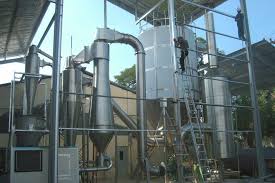Introduction to Spray Drying Capabilities
Spray drying equipment is pivotal in various industries, from food and beverage to pharmaceuticals and materials science. This technology excels at transforming liquid or slurry into dry powder through a rapid and efficient drying process. Understanding the key features that optimize performance and versatility in spray drying equipment is essential for any operation focusing on quality and efficiency.
Adjustable Temperature Controls
Precise temperature control is vital in spray drying. It affects the integrity and quality of the final product. Most high-quality spray drying equipment provides a broad range of temperature settings, typically from 100°C to 300°C, allowing operators to tailor the process to the specific thermal sensitivities of the product being dried. This feature ensures that enzymes or vitamins in food products and heat-sensitive chemicals in pharmaceuticals are preserved during drying.
Atomization Technology
The atomizer is the heart of spray drying equipment, where the liquid feedstock is transformed into a fine mist. The efficiency and quality of drying depend largely on the atomizer’s design and function. Two common types of atomizers are rotary and nozzle atomizers. Rotary atomizers can handle a wide viscosity range and create powders with relatively uniform particle sizes, while nozzle atomizers are better suited for producing coarse droplets and handling high-viscosity fluids.
Air Flow Configuration
Effective air flow management is another crucial feature. Spray dryers typically use one of three air flow configurations: co-current, counter-current, and mixed flow. Co-current flow, where air and spray move in the same direction, is most effective for heat-sensitive materials as it quickly reduces the temperature of the drying air, preserving the material’s active properties. Counter-current, on the other hand, is suited for more robust materials requiring intense drying power.

Efficiency and Energy Use
A key characteristic of effective spray drying equipment is its ability to operate efficiently, minimizing energy use while maximizing output. Advanced spray dryers incorporate heat recovery systems that recycle the heat generated during the drying process. This not only reduces the energy consumption but also lowers operational costs significantly.
Scalability and Flexibility
Scalability is critical, especially for industries that need to ramp up production volumes without compromising product quality. Modern spray drying equipment is designed to be scalable, from small pilot scales to large-scale production, with easy transitions between different operating sizes. Flexibility in processing different types of solutions and slurries also makes these machines invaluable across multiple applications.
Safety and Maintenance Features
Safety cannot be overlooked. Reliable spray drying equipment comes with built-in safety features like explosion vents, real-time monitoring systems, and automatic shutdown mechanisms in case of overheating or other failures. Maintenance ease is equally important, with designs that allow easy access to internal components for cleaning and repair, ensuring longevity and consistent performance.
Discover More about Spray Drying Equipment
For more information on advanced features and the latest innovations in spray drying equipment, visit this resource.
Conclusion
The effectiveness of spray drying equipment hinges on its ability to deliver precision, efficiency, and adaptability. From adjustable temperature controls and sophisticated atomization to smart energy use and robust safety protocols, each feature plays a crucial role in meeting the demands of modern production environments. With the right equipment, businesses can achieve consistent product quality, reduce operational costs, and maintain high safety standards.